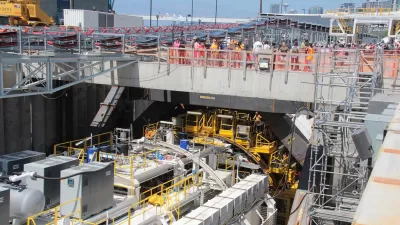Though Seattle's giant tunneling machine remains stuck 60 feet under South Main Street, muck is starting to be flung above the surface. An email from Washington's Transportation Secretary reveals concerns over the conduct of the machine's operators.
As the mystery behind what's blocking Seattle's tunnel-boring behemoth remains unsolved more than 6 weeks after digging was halted in the area beneath Pioneer Square, questions are being raised about contractor Seattle Tunnel Partners' (STP) operations in the months prior to the work stoppage. "State Transportation Secretary Lynn Peterson says the agency 'has had concerns' about how contractors have been operating tunnel-boring machine Bertha since July 30, when drilling began," reports Mike Lindblom.
In an email sent last week to state lawmakers, Peterson remarked that:
WSDOT has had concerns about the machine’s operations and critical systems since its launch on July 30, 2013. We have discussed these concerns with STP frequently over the past five months and this week sent a formal letter stating our concerns and asking STP how they will address them prior to tunneling under the viaduct and downtown. We are providing you [elected officials] with this information in lieu of a copy of the letter because it could be the subject of a potential future litigation between WSDOT and the contractor.
"Chris Dixon, project director for STP, didn’t comment Wednesday on Peterson’s message," notes Lindblom. "But earlier Wednesday, he said the contractors think something in the soil, as opposed to mechanical trouble, is to blame for the stall." Reports earlier this month suggested that an eight-inch metal pipe was responsible for the stoppage.
FULL STORY: State questions Bertha strategy, sees ‘potential future litigation’

Study: Maui’s Plan to Convert Vacation Rentals to Long-Term Housing Could Cause Nearly $1 Billion Economic Loss
The plan would reduce visitor accommodation by 25,% resulting in 1,900 jobs lost.

North Texas Transit Leaders Tout Benefits of TOD for Growing Region
At a summit focused on transit-oriented development, policymakers discussed how North Texas’ expanded light rail system can serve as a tool for economic growth.

Why Should We Subsidize Public Transportation?
Many public transit agencies face financial stress due to rising costs, declining fare revenue, and declining subsidies. Transit advocates must provide a strong business case for increasing public transit funding.

How to Make US Trains Faster
Changes to boarding platforms and a switch to electric trains could improve U.S. passenger rail service without the added cost of high-speed rail.

Columbia’s Revitalized ‘Loop’ Is a Hub for Local Entrepreneurs
A focus on small businesses is helping a commercial corridor in Columbia, Missouri thrive.

Invasive Insect Threatens Minnesota’s Ash Forests
The Emerald Ash Borer is a rapidly spreading invasive pest threatening Minnesota’s ash trees, and homeowners are encouraged to plant diverse replacement species, avoid moving ash firewood, and monitor for signs of infestation.
Urban Design for Planners 1: Software Tools
This six-course series explores essential urban design concepts using open source software and equips planners with the tools they need to participate fully in the urban design process.
Planning for Universal Design
Learn the tools for implementing Universal Design in planning regulations.
Ascent Environmental
Borough of Carlisle
Institute for Housing and Urban Development Studies (IHS)
City of Grandview
Harvard GSD Executive Education
Toledo-Lucas County Plan Commissions
Salt Lake City
NYU Wagner Graduate School of Public Service



























